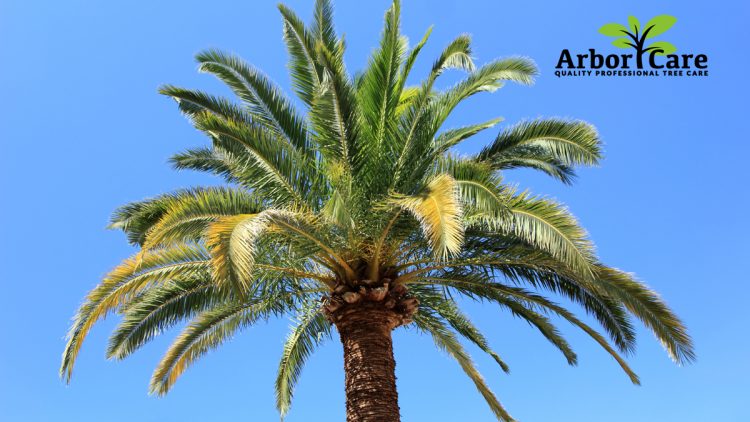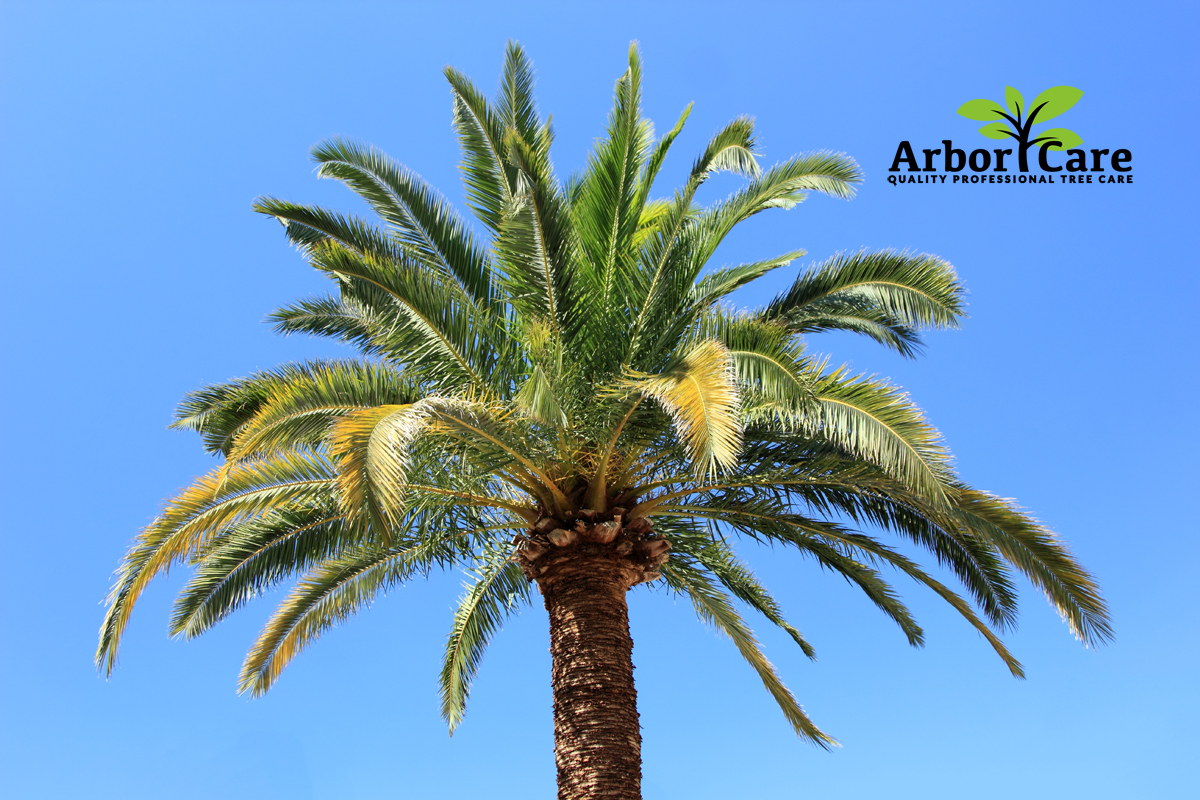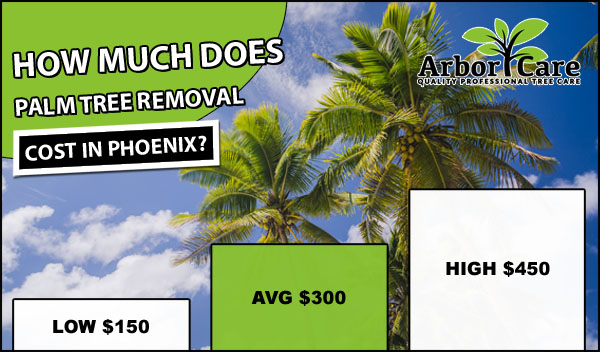Palm Tree Removal Costs

Is there a palm tree on your property that needs to be cut down? It would be beneficial to acquire an estimate of the cost. We scoured the internet for tree removal estimates in order to provide you with the most accurate estimate for palm tree removal costs.
The Cost Of Removal Will Vary Depending On The Size Of The Palm Tree:
- $100 – $450 for small trees (up to 30 feet.)
- $300 – $900 for medium trees (30-50 feet.)
- $850-$1,800 for large trees (60-80 feet.)
If you’re thinking about removing the palm yourself, you should think twice. Continue reading to learn why palm trees might be tough to remove without the help of a professional. We’ll also tell you about other aspects that may influence the overall cost of palm tree removal.
Is It Simple To Get Rid Of Palm Trees?
Tree removal, in general, is a dangerous job, and palm tree removal is no exception. If you’re thinking about doing your own palm tree removal, be mindful of the risks. Felling a palm can put you and your home in danger. We strongly advise employing professionals to remove trees because they have the necessary equipment, safety clothing, and skills to avoid a disaster.
Palm trees are difficult to remove for a variety of reasons, all of which have an impact on the total cost of tree removal:
- Height.
- The state of the tree.
- Palm tree species
- The palm’s location on your property.
- Stump removal is a service that we provide.
- Clean-up.
- Emergency eviction.
Height
The majority of the cost of palm tree removal is due to its height. Small trees pose a lower risk overall since they are easier to manage and require less cleanup. Large trees are difficult to manage and create more mess to clean up.
If you want to save some money, consider cleaning up and taking away the debris once the palm tree has been securely chopped down. Because the cost is mostly based on height, dying or dead trees often cost the same as living trees to be removed.
Condition
If you’ve been routinely pruning your palms, you’re in good shape because they’ll be easier and less expensive to remove. Canopies that aren’t kept in good shape are dangerous since loose fronds might fall and cause damage below. Removing untidy canopies will increase the expense of professional tree removal because it is labor-intensive and time-consuming.
Species Of Palm
The trunks of palm trees are extremely dense and tough to cut through. The trunk of a palm can be smooth, fibrous, or spiny, depending on the species. The cost of palm tree removal is determined by the complexity and diameter of the trunk. The removal of palm species with bigger trunk diameters and fibrous or spiny trunks is more expensive.
The Property’s Location
The position of the palm tree on your property can have a big impact on the price of removal, especially if there are overhead risks, surrounding buildings, parking lots, fences, or other obstacles that make it difficult for specialists to use their equipment. Professionals may also need to employ ropes or pulleys to steer the tree away from dangers and safely to the ground.
To make room for palm tree removal, remove any outside furniture, lawn ornaments, ornamental lighting, potted plants, children’s toys, and other items from the area.
Removal In An Emergency
You should expect to pay more for quick service if your palm tree has been damaged or constitutes a safety issue and needs to be removed right away. Check your homeowner’s insurance coverage to see if the expense of removing a dangerous palm tree is covered.
Fees Not Included
Before choosing a professional tree removal company, always receive a written quote. If the professional needs to travel a considerable distance and bring equipment to your home, don’t be afraid to inquire about additional fees such as mileage compensation.
For larger trees and protected palm species, check with your local government to see if a permission is required for tree removal. Permits for tree removal typically cost between $60 and $150.
What Is The Best Way To Get Rid Of A Huge Palm Tree?
We recommend contacting a professional tree removal service for huge palm palms in particular. When you hire professionals, you can be rest assured that you’ll have enough employees, the right equipment, and safety precautions in place for a safe palm tree removal.
You should also verify local rules regarding huge tree removal, as some may require you to first obtain a permission. Again, seek the advice of a professional tree removal agency because they will be familiar with the local rules and can best guide you through the procedure. Tree removal companies may also advise you on how to dispose of palm tree waste in your location.
Palm Tree Roots: How Deep Do They Go?
Palm trees have fibrous, shallow root systems. The primary root ball is contained inside the first three feet of soil, while the expanding fiber system stretches outward to roughly the palm’s canopy circle.
Do Palm Trees Destroy Concrete Foundations?
Palm tree roots are extremely unlikely to crack or destroy a concrete foundation due to their delicate horizontal root systems. However, we recommend planting palms (particularly larger species) at least 12-feet away from solid structures for the palm’s health and the safety of your structures.
Here are some suggestions for using palm trees into your landscaping to boost home value:
- Choose palm species that will grow well in your USDA Plant Hardiness Zone.
- Be careful where you plant palm trees so that they don’t become a hazard to the property.
- Trim palm tree canopies and keep them pest-free.
Is it Time to Get Rid of That Palm Tree?
Consult an arborist for a professional advice based on a tree examination if you’re not sure if a palm tree has to be removed. Arborists normally charge by the task, with an examination costing around $150 and a written report costing up to $400. To acquire a permit, arborist reports may be required.
The following are important reasons to remove a palm tree:
- An infestation is causing damage to the tree, as well as spreading to adjacent trees and structures.
- The illness is wreaking havoc on the tree.
- The tree is rendered potentially hazardous due to irreversible damage.
- Redesigning the landscape or building in the vicinity of the tree
- The palm tree is no longer alive.
Get A Palm Tree Trimming or Removal Quote In Phoenix, AZ
If you are interested in receiving a free cost quote for Palm Tree Trimming anywhere in the Phoenix Valley, let Arbor Care Help!
We provide affordable Palm Tree Trimming services in Phoenix, Scottsdale, Chandler, Scottsdale, Gilbert, Glendale, Mesa, among others. Remove those sick or dead Palm Trees and enhance your residential yard or commercial property.





